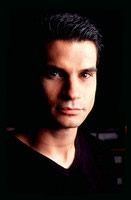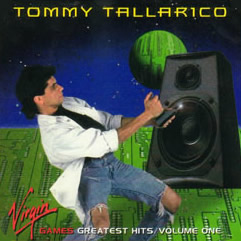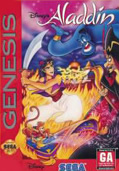For the last fifteen years, Tommy Tallarico has been producing some of the most amazing music in gaming, having worked on such hits as Earthworm Jim 1 & 2, Aladdin (Genesis), both Maximo titles, and Terminator (Sega CD). He’s worked on just about every system since the Amiga and has scored soundtracks for over a hundred different titles. The first to use Q-Sound (3D audio), he played a huge part in bringing 5.1 surround sound to video games. In 1994 he founded Tommy Tallarico Studios, which is the largest audio production house in the industry.
hundred different titles. The first to use Q-Sound (3D audio), he played a huge part in bringing 5.1 surround sound to video games. In 1994 he founded Tommy Tallarico Studios, which is the largest audio production house in the industry.
As the founder of G.A.N.G. (Game Audio Network Guild), a non-profit organization dedicated to spreading awareness for audio in the interactive world and an advisory member for the Game Developers Conference, Mr. Tallarico has become one of the strongest voices in gaming. He currently hosts both Judgment Day and the award-winning Electric Playground (which he also writes and co-produces) on G4, and he is the creator and executive producer of Video Games Live, which provides a wonderful concert experience featuring classic and modern game themes. Additionally, he has released several soundtrack albums, including two greatest hits CDs.
Sega-16 recently spoke to Mr. Tallarico about his experiences composing for the Genesis and Sega CD, as well as his work throughout the industry.
Sega-16: How did you first get started in creating music in the gaming industry?
Tommy Tallarico: I’m originally from Springfield, Massachusetts. When I was a kid, I always wanted to move to Southern California to be a professional musician. When I turned twenty-one, I left Mass. and drove across country to Southern California. The only thing I really knew out here was Hollywood, so I drove to Hollywood. I didn’t have a place to stay, didn’t know anybody, didn’t have a job, and, oh yeah, I didn’t have any money. So, I showed up in Hollywood, took a look around, and said, “What the hell is this!?” For those of you who have been to Hollywood, you know what I’m talking about. Hollywood isn’t exactly the way they portray it on TV! The only other thing I knew in California was Disneyland, so I stopped some bum on the street and asked him where Mickey Mouse lived. He pointed me about forty-five minutes south to Orange County. When I got to Orange County, I said, “Now this is more like it!” So, I picked up a newspaper, and I got a job the very next day selling keyboards at Guitar Center. I was sleeping either in my car or on Huntington Beach at this point, so I was looking for anything I could find. The next day I started, and believe it or not, the very first person to walk in the store that I waited on happened to be a producer for a new software company called Virgin Mastertronic.
I’ve loved music my whole life and I’ve been playing piano since I was three years old. My second love has always been video games. Never in my whole life did I ever think of putting my two loves together… until that day. I became the first tester at Virgin the next day. There were only about fifteen people at Virgin at the time, so they didn’t need a full-time musician. When the first opportunity arose for music (Prince of Persia), I jumped on it. The VP of the company was so impressed he made me the music guy!
Sega-16: What do you do to begin working on a soundtrack? Do you have a standard routine or is it different for each game?
Tommy Tallarico: First I’ll sit down with the designer and figure out what the entire vision is for the game. I see artwork, drawings, and hopefully gameplay. Then, I may engulf myself with a similar style of music that I was thinking may fit the project. For example, for Advent Rising, there are a lot of emotional and epic scenes in which I wanted to use an opera style for. So, I listened to a lot of opera and classical music before starting to write for the project. When I start composing, I’ll play the game with no sound until stuff starts coming to me in my head. Then, I start figuring it out on my piano or synthesizer. I always try to just create a really good tune that could stand on its own even after the game is shut off.
Sega-16: The Genesis sound chip wasn’t as advanced as the SNES’s. How hard was it to create the quality of music you’re famous for on such limited hardware?
Tommy Tallarico: It was challenging, but for me, that was the fun part. I think mostly what I did early on was give the players the kind of music they wanted to hear. I remember playing games and thinking “This music sucks!” It sounds like a merry-go-round tune or some childish bleeps and blips. Why weren’t people doing rock, pop, blues, orchestral, dance, techno, etc.? No one had ever really heard a real guitar in a video game until the early ’90s. I was lucky because I entered the industry when we were on the verge of using midi files, software and technology for creating music. Before that, the only way to create music was to program it by hand. I don’t know too much about programming at all.
Another thing I started doing was to introduce lots of musical samples right into the cartridge MIDI files. Back in the old days on the Sega Genesis, people would use the sample chip to play a scratchy voice sample (“FIGHT”) or use it to intro the company name (“SE-GA”) I decided why not have that sample channel be playing as much as possible. I had convinced programmers that if they gave me enough space I would make the Genesis sound like no one has ever heard. So, I used kick drum and snare drum samples, guitar and horn hits, singing voices, etc. right in the music. On top of that, I would use as many real sampled sound FX as I could, by prioritizing every sound in the game I was able to constantly have the sample chip playing without any recognizable drop out when other things took priority. If you go back and listen to games like Global Gladiators, Cool Spot, Earthworm Jim 1 & 2 or Aladdin you’ll hear samples going off all the time. No one ever really did that.
Sega-16: Were any special tools made available to you by Sega?
 Tommy Tallarico: Absolutely! It was called the G.E.M.S. audio tool. I think it stood for “Genesis Emulation Music Software.” It was written by Jon Miller who was Mark Miller’s brother! (Mark was the composer behind such greats as Toe Jam & Earl). I know that Mark had a lot of input in the design and creation as well. The tool plugged into the Genesis like a cartridge and connected to your PC which enabled me to tweak the audio chip sounds on the Genesis in real time and use the Genesis to record MIDI right onto my sequencer. So, it was like I was using the Genesis just like I would use and synthesizer or sampler. Without that tool I would have been screwed!
Tommy Tallarico: Absolutely! It was called the G.E.M.S. audio tool. I think it stood for “Genesis Emulation Music Software.” It was written by Jon Miller who was Mark Miller’s brother! (Mark was the composer behind such greats as Toe Jam & Earl). I know that Mark had a lot of input in the design and creation as well. The tool plugged into the Genesis like a cartridge and connected to your PC which enabled me to tweak the audio chip sounds on the Genesis in real time and use the Genesis to record MIDI right onto my sequencer. So, it was like I was using the Genesis just like I would use and synthesizer or sampler. Without that tool I would have been screwed!
Sega-16: People to this day talk about how great the Genesis version of Aladdin was and the soundtrack definitely played a huge part in its success. How hard was it to convert an Academy Award-winning score onto such a small cart?
Tommy Tallarico: I incorporated the help of Donald Griffin during that project. Donald was a great arranger & orchestrator (as well as composer). I would decide which tune I wanted from the film and then send him a copy. It was then his job to try and turn it into a smaller voiced midi file. From there, I would literally go through every single note in every single midi file of the entire game one by one to assign it the proper sound, value, priorities, length, volume, etc. It was a painstaking process but one that I think was well worth it. The melodies in the music were really phenomenal, so it was easier to take great melodies and break them down to the smallest possible voices. We had also composed some original music as well, which fit into the style of the film & game. Once a song was done, it then came down to incorporate all of the sound effects and trying to figure out priorities so when sound effects played it wouldn’t drop too much of the music. Always a very important process that when done right is almost invisible to the player, yet I was still able to get the most out of the sound chip. We were always thrashing that thing to the max.
Sega-16: After mostly working with carts, you were really able to cut loose on the Sega CD and it shows in your incredible soundtrack for Terminator. What was it like to compose for Sega’s ill-fated add-on?
Tommy Tallarico: I was really cool. The Terminator was the first game to incorporate 3D Q-Sound (even though Ecco came out a littler earlier) but more importantly… it was the first game to ever use a live guitar! When CD-ROM’s first hit as a storage medium I think some audio people were caught a little off guard and didn’t know what to do. A lot of them were programmers as opposed to composers, and they were still producing video game midi music.. they were just putting it on CD now. I really wanted to make an impact on CD. As far as production quality went, there were no limitations. I convinced the V.P. of Virgin at the time (Dr. Stephen Clarke-Willson who was a good musician himself) to spend money on going to a quality studio (A&M) and spending money on the mix & mastering. He agreed, and I think it really helped the project. Another interesting story about The Terminator is that I had met and hired a really great engineer from Q-Sound to mix the game. His name was Buzz Burrowes. It was his first gig in the video game industry. Buzz went on to become a super big wig at Sony Computer Entertainment, heading up both the music & video departments for all of SCE. Buzz was also the guy who created the SCREAM audio engine for the PS2 & PSP, which is one of the most incredible audio tools in the history of the video game industry!
Sega-16: How much liberty are you usually given in regards to a licensed game’s score?
Tommy Tallarico: It really depends on the attitude and owner of the music and/or the license. These days, it’s pretty easy to convince owners that video games are a legitimate form of entertainment and the intellectual property is only going to benefit by having the music in there as well.
Sega-16: Are there any other games you would have liked to have scored but didn’t?
Tommy Tallarico: I loved Beyond Good & Evil and thought it had an amazing score. Even though it wasn’t a huge seller, I loved the style and sound of the game. I’d LOVE to do the music for a Tron game! Although, I understand they are re-doing the film, so maybe I’ll get a shot at doing the actually movie. That would be a dream come true!
Sega-16: Of all the games you’ve scored to date, do you have any favorites?
 Tommy Tallarico: Absolutely! There’s a few… I’d say Global Gladiators on the Genesis because it was my first real full audio project & the first time I worked with one of my best friends, David Perry. It also won me my first award. Earthworm Jim 1 & 2 because of the team and the fact that we were making something we all enjoyed – no politics, game design docs, publisher pressure, etc., just a bunch of friends creating something they all thought was cool & funny. And finally, I’d say Advent Rising because I feel the music, sound design, & dialogue came out exactly the way I had envisioned from the beginning and will hopefully have a real impact on the way people think of audio for games.
Tommy Tallarico: Absolutely! There’s a few… I’d say Global Gladiators on the Genesis because it was my first real full audio project & the first time I worked with one of my best friends, David Perry. It also won me my first award. Earthworm Jim 1 & 2 because of the team and the fact that we were making something we all enjoyed – no politics, game design docs, publisher pressure, etc., just a bunch of friends creating something they all thought was cool & funny. And finally, I’d say Advent Rising because I feel the music, sound design, & dialogue came out exactly the way I had envisioned from the beginning and will hopefully have a real impact on the way people think of audio for games.
Sega-16: Lastly, the question 16-bit fans have always wanted to ask you: Which did you prefer as a gamer: Genesis or SNES? Why?
Tommy Tallarico: Genesis for sure. I got my first real start as a composer on the Genesis. The audio tools were always a lot better on the Genesis, and as a player, I loved the sports titles & platformers that the Genesis had. Although, I must say that Super Mario World was one of my favorite games of all time.
Sega-16 would like to thank Mr. Tallarico for taking the time to talk to us. If you’d like to know more about him, be sure to visit his website. Remember to watch Judgment Day weekdays on G4 and new episodes of Electric Playground every Sunday night at 10:30 PM and Saturdays and Sundays at 10:00 PM EST/7:00 PM PST on MTV Canada. Moreover, check out the tour schedule for Video Games Live, which will be a twenty-five city tour throughout the U.S. & Canada!

Recent Comments